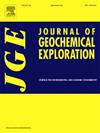Discrimination of carbonatite and Mississippi Valley-type deposits by partial least squares-discriminant analysis of trace elements and Mg isotope compositions in dolomite
IF 3.3
2区 地球科学
Q1 GEOCHEMISTRY & GEOPHYSICS
引用次数: 0
Abstract
Carbonatite-related rare earth element (REE), Nb, fluorite, and phosphate deposits and Mississippi Valley-type (MVT) deposits containing Zn, Pb, Ag, and Ge are increasingly important sources of critical metals and minerals. Geochemical classification of carbonatite-related and MVT deposits using chemical compositions of dolomite, the most common gangue mineral in such deposits, is potentially useful for tracing the deposit types and assisting in mineral exploration. Here, we studied variations in elemental contents (42 elements) and δ26Mg of dolomite from deposits in the eastern Canadian Cordillera, where carbonatite-related and MVT deposits coexist, to examine its usefulness for geochemical discrimination.
Our dataset showed systematic differences between carbonatite and MVT deposits: dolomites from carbonatites were enriched in Fe, Ga, Sr, As, Ba, REEs, and Th and had high δ26Mg values, whereas dolomites from MVT deposits were enriched in Zn and Pb, but there were obvious overlaps. We developed an accurate discrimination model by performing a partial least squares regression-discriminant analysis (PLS-DA) that considered all variables simultaneously. The results of PLS-DA showed that two components were sufficient for accurate classification of dolomites from the two deposit types in the study area in comparison with the results of principal component analysis and liner discriminant analysis (PCA-LDA). The δ26Mg, Sr/Mg, Zn/Mg, Ba/Mg, and Pb/Mg yielded the highest variable importance on projection (VIP) scores, which is consistent with the geochemical parameters expected from previous studies on carbonatites and MVT deposits. Furthermore, we applied the developed discrimination model to a dataset of dolomite from other deposit (Rock Canyon Creek deposit) and unmineralized dolomite from the host rocks. The dolomites from the Rock Canyon Creek deposit were classified as carbonatite-related deposits, consistent with recent research, although their elemental signatures differ greatly from those of typical carbonatite-related deposits. The unmineralized dolomite plotted separately from the mineralized dolomite samples in the PLS-DA score plots. Our results suggest that PLS-DA score plots of dolomite chemistry are useful for classifying deposit types and probably applicable to exploration for critical metals and minerals associated with carbonatite-related and MVT deposits.
白云岩中微量元素和Mg同位素组成的偏最小二乘法判别碳酸盐岩和密西西比河谷型矿床
碳酸盐岩相关稀土元素(REE)、铌、萤石、磷酸盐矿床和含Zn、Pb、Ag、Ge的密西西比河谷型(MVT)矿床是日益重要的关键金属矿物来源。利用白云岩(这类矿床中最常见的脉石矿物)的化学成分对碳酸盐岩和MVT矿床进行地球化学分类,可能有助于追踪矿床类型和协助矿物勘探。在这里,我们研究了来自加拿大东部Cordillera矿床的白云岩元素含量(42种元素)和δ26Mg的变化,该矿床与碳酸盐岩和MVT矿床并存,以检验其对地球化学识别的有效性。研究结果显示,碳酸盐岩和MVT矿床的白云岩富集Fe、Ga、Sr、As、Ba、ree和Th, δ26Mg值较高,而MVT矿床的白云岩富集Zn和Pb,但存在明显的重叠。我们通过同时考虑所有变量的偏最小二乘回归-判别分析(PLS-DA)建立了一个准确的判别模型。PLS-DA结果表明,与主成分分析和线性判别分析(PCA-LDA)结果相比,2个组分足以对研究区2种矿床类型的白云岩进行准确分类。δ26Mg、Sr/Mg、Zn/Mg、Ba/Mg和Pb/Mg的预测变量重要度(VIP)得分最高,与前人碳酸盐岩和MVT矿床的地球化学参数预测值一致。此外,我们将建立的识别模型应用于其他矿床(岩石峡谷溪矿床)的白云岩和来自主岩的未矿化白云岩数据集。岩石峡谷溪矿床白云岩的元素特征与典型碳酸盐岩矿床存在较大差异,但与近期研究结果一致,属于碳酸盐岩相关矿床。在PLS-DA评分图中,未矿化白云岩与矿化白云岩样品分开绘制。我们的研究结果表明,PLS-DA白云岩化学评分图对矿床类型分类很有帮助,可能适用于碳酸盐岩和MVT矿床的关键金属和矿物的勘探。
本文章由计算机程序翻译,如有差异,请以英文原文为准。
求助全文
约1分钟内获得全文
求助全文
来源期刊

Journal of Geochemical Exploration
地学-地球化学与地球物理
CiteScore
7.40
自引率
7.70%
发文量
148
审稿时长
8.1 months
期刊介绍:
Journal of Geochemical Exploration is mostly dedicated to publication of original studies in exploration and environmental geochemistry and related topics.
Contributions considered of prevalent interest for the journal include researches based on the application of innovative methods to:
define the genesis and the evolution of mineral deposits including transfer of elements in large-scale mineralized areas.
analyze complex systems at the boundaries between bio-geochemistry, metal transport and mineral accumulation.
evaluate effects of historical mining activities on the surface environment.
trace pollutant sources and define their fate and transport models in the near-surface and surface environments involving solid, fluid and aerial matrices.
assess and quantify natural and technogenic radioactivity in the environment.
determine geochemical anomalies and set baseline reference values using compositional data analysis, multivariate statistics and geo-spatial analysis.
assess the impacts of anthropogenic contamination on ecosystems and human health at local and regional scale to prioritize and classify risks through deterministic and stochastic approaches.
Papers dedicated to the presentation of newly developed methods in analytical geochemistry to be applied in the field or in laboratory are also within the topics of interest for the journal.
 求助内容:
求助内容: 应助结果提醒方式:
应助结果提醒方式:


